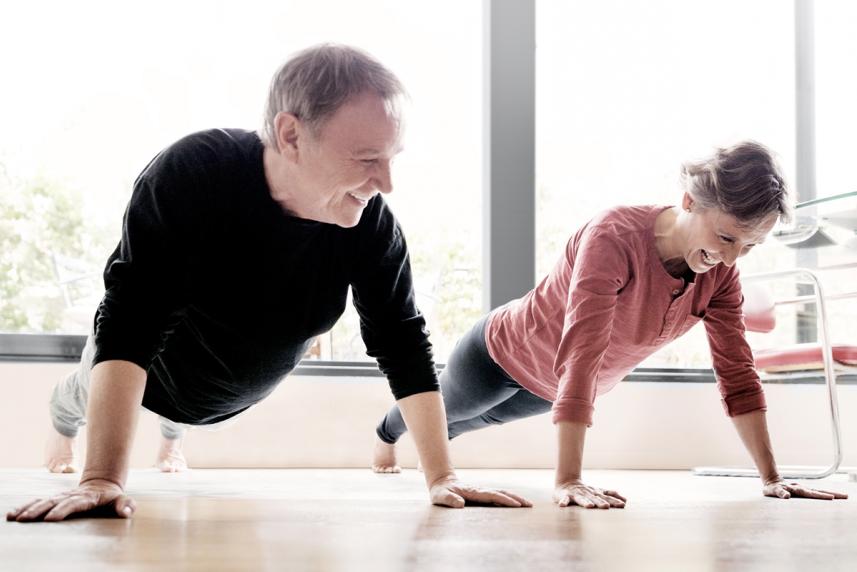
We have more than 90,000 doctors at over 2,000 locations. Our team will help you get the care you need, when and where you need it.

Adding short bursts of high-effort activity into your fitness routine can help you lose weight, get stronger and stay healthy. The best part? You can adapt this plan to your favorite moves or use it to start a new fitness journey.
Short on time but still want to get in a great workout? Try high-intensity interval training (HIIT).
HIIT plans offer all the same great benefits as aerobic workouts, including:
And they do it all in a fraction of the time.1
“These workouts get your heart rate up. They challenge your body and improve your ability to heal,” says Adam Ortiz. He’s a health coach with Rally Health, part of Optum, in Arvada, Colorado.
These routines alternate between short bursts of high-intensity exercise and slightly longer periods of recovery. The intervals can vary in length, but they’re meant to be on the shorter side. You might do a 15- to 30-second burst of high-effort sprinting. Then follow it with 45 seconds to 2 minutes of easy running or walking to help your heart rate slow down.
Then you repeat that cycle four to six times. The whole workout usually lasts no more than 20 minutes. And it can do it in even less time.
HIIT workouts are also versatile. You can do them using strength or cardio moves. And you can do them from anywhere: the pool, the gym, or your backyard or local park. Sprinting, cycling and jumping rope are popular HIIT workouts.
Interval training is convenient. But it also offers unique health benefits, including:
A quick way to burn calories and fat. You can burn more calories with a 30-minute HIIT session than with other forms of exercise, says Ortiz.
You boost your metabolism. In other words, you increase how quickly you burn calories for energy. Plus, the calorie-burning keeps going even after you’re done. You get what’s called an afterburn.
Your body improves its ability to recover efficiently. The HIIT workout model helps your body strengthen its ability to get your heart rate back down after it spikes. A quicker recovery rate means your body gets the oxygen it needs faster. This allows for quicker recovery between exercises.
You’re less likely to get bored. The intervals keep changing. Plus, it’s over before you know it.
You can lower your risk of serious illness. Your odds of heart disease, high blood pressure, type 2 diabetes, and colon and lung cancers all go down. And it may help improve your brain health, mental health and overall well-being.2
Read more about the benefits of living an active life.

We have more than 90,000 doctors at over 2,000 locations. Our team will help you get the care you need, when and where you need it.
Ready to give HIIT a go? First get the OK from your doctor. Here’s one thing to remember. Your “high intensity” may not be anything like your friend’s high intensity. And that’s 100% fine. One of the nice things about HIIT workouts is how well they work with different fitness levels. If you’re just starting out, try walking. Just shorten your high-intensity intervals. Looking for more of a challenge? Add more resistance or weight. You can also make your high-effort intervals a little longer.
Also handy? A digital watch so that you can time your intervals. You can also use the timer on your smartphone.
Choose your focus: cardio or strength. With just 10 minutes, you’ll want to stay focused. If you’re at the gym, you can use an elliptical machine or treadmill for cardio. If you’re at home, you can use the stairs or head out to the sidewalk. And if you’re in a pool, you can run in place or swim.
For a strength workout instead, focus on moves that work multiple muscles, says Ortiz. Those can get your heart rate up quickly. Some of Ortiz’s favorite moves for HIIT training are:
Warm up: No matter where you are or how you are getting sweaty, make sure you warm up your body first.
HIIT it: Now it’s time to cycle.
Do 15 to 30 seconds of hard-effort exercise. Then follow with 45 seconds to one minute of recovery.
“Aim for one to two times the amount of recovery for each active interval,” says Ortiz. And then repeat for 10 minutes.
The high effort part should be hard, says Billy Ryan, a fitness coach with Rally Health, part of Optum, in Chicago. You’ll know you’re doing it right if your lungs are burning and your heart is pumping. You might even want to quit because it’s so hard, he says.
On a scale of 1 to 10, aim for an 8 to 10.
And recovery should be easy. Take it back down to the lower end of the scale. Your effort level should be no higher than a 4 or 5. “If you’re not recovering enough, you won’t be able to give your best effort on the next interval,” says Ortiz.
Cool down: The cooldown is just as important as the warm-up. Take a few minutes to walk around or do some easy cardio. And finish with some gentle stretches.
Need a little push to get started? We've got plenty of workout motivation here.
Limit your HIIT workouts to one to three times per week. Your body needs time to rest and recover. Start with once a week to ease yourself into these workouts.
Pay attention to your form. As you get tired, your form can start to break down. That can make the moves less efficient. It can also increase your risk of injury.
Don’t push too hard. You never want to feel faint or dizzy. HIIT workouts can be hard. “But you shouldn’t want to pass out,” says Ryan.
Get health tips delivered straight to your inbox. Sign up for our health and wellness newsletter today.
Sources
© 2024 Optum, Inc. All rights reserved. Do not reproduce, transmit or modify any information or content on this website in any form or by any means without the express written permission of Optum.
The information featured in this site is general in nature. The site provides health information designed to complement your personal health management. It does not provide medical advice or health services and is not meant to replace professional advice or imply coverage of specific clinical services or products. The inclusion of links to other web sites does not imply any endorsement of the material on such websites.
Consult your doctor prior to beginning an exercise program or making changes to your lifestyle or health care routine.
Stock photo. Posed by model.